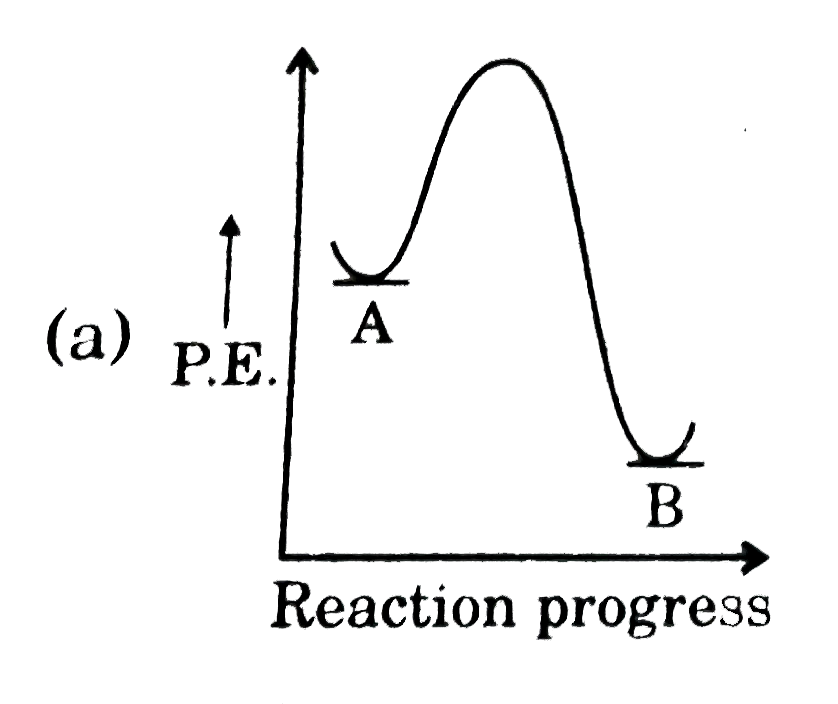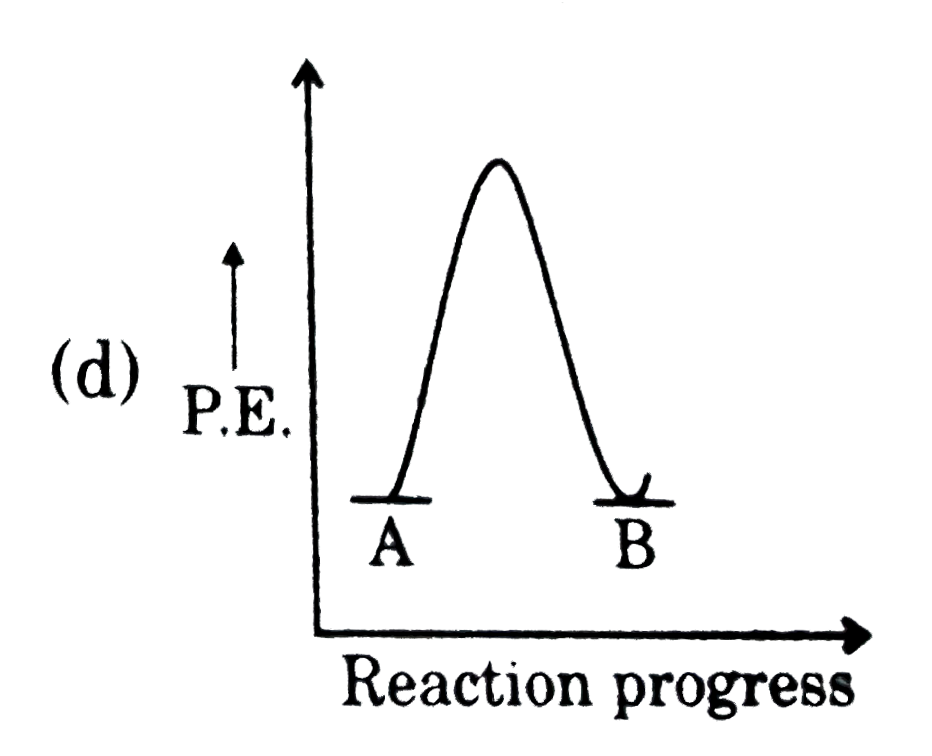For a reaction A→B,Ea=10kJmol−1,ΔH=5kJmol−1. Thus, potential energy profile for this reaction is:




The correct Answer is:B
To solve the problem regarding the potential energy profile for the reaction A→B with given values of activation energy (Ea=10kJ mol−1) and enthalpy change (ΔH=5kJ mol−1), we can follow these steps:
1. Understand the Definitions:
- Activation Energy (Ea): This is the minimum energy required for a reaction to occur. The given Ea=10kJ mol−1 is for the forward reaction.
- Enthalpy Change (ΔH): This indicates whether a reaction is exothermic or endothermic. A positive ΔH=5kJ mol−1 means the reaction is endothermic.
2. Determine the Activation Energy for the Backward Reaction:
- We can use the relationship:
ΔH=Eforwarda−Ebackwarda
- Plugging in the values:
5=10−Ebackwarda
- Rearranging gives:
Ebackwarda=10−5=5kJ mol−1
3. Sketch the Potential Energy Profile:
- On the y-axis, represent potential energy.
- Start with the potential energy of reactant A at a certain level.
- Draw a peak at the activation energy for the forward reaction, which is 10kJ mol−1 above the energy level of A.
- From the peak, drop down to the energy level of product B. Since ΔH=5kJ mol−1, the energy level of B will be 5kJ mol−1 higher than that of A.
4. Label the Diagram:
- Label the starting point as A, the peak as the transition state, and the endpoint as B.
- Indicate the activation energy for the forward reaction (Eforwarda=10kJ mol−1) and the activation energy for the backward reaction (Ebackwarda=5kJ mol−1).
5. Conclusion:
- The potential energy profile illustrates that the reaction is endothermic, as the products are at a higher energy level compared to the reactants.
- Activation Energy (Ea): This is the minimum energy required for a reaction to occur. The given Ea=10kJ mol−1 is for the forward reaction.
- Enthalpy Change (ΔH): This indicates whether a reaction is exothermic or endothermic. A positive ΔH=5kJ mol−1 means the reaction is endothermic.
- We can use the relationship:
ΔH=Eforwarda−Ebackwarda
- Plugging in the values:
5=10−Ebackwarda
- Rearranging gives:
Ebackwarda=10−5=5kJ mol−1
- On the y-axis, represent potential energy.
- Start with the potential energy of reactant A at a certain level.
- Draw a peak at the activation energy for the forward reaction, which is 10kJ mol−1 above the energy level of A.
- From the peak, drop down to the energy level of product B. Since ΔH=5kJ mol−1, the energy level of B will be 5kJ mol−1 higher than that of A.
- Label the starting point as A, the peak as the transition state, and the endpoint as B.
- Indicate the activation energy for the forward reaction (Eforwarda=10kJ mol−1) and the activation energy for the backward reaction (Ebackwarda=5kJ mol−1).
- The potential energy profile illustrates that the reaction is endothermic, as the products are at a higher energy level compared to the reactants.
Topper's Solved these Questions
- GRAPHICAL INTERPRETATIONBook:GRB PUBLICATIONChapter:GRAPHICAL INTERPRETATIONExercise:I.Electrochemistry
Explore 1 Video
- GRAPHICAL INTERPRETATIONBook:GRB PUBLICATIONChapter:GRAPHICAL INTERPRETATIONExercise:Electrochemistry
Explore 9 Videos
- GRAPHICAL INTERPRETATIONBook:GRB PUBLICATIONChapter:GRAPHICAL INTERPRETATIONExercise:H. Chemical Kinetics
Explore 1 Video
- F-BLOCK ELEMENTSBook:GRB PUBLICATIONChapter:F-BLOCK ELEMENTSExercise:Subjective type
Explore 7 Videos
- HYDROCARBON (ALIPHATIC)Book:GRB PUBLICATIONChapter:HYDROCARBON (ALIPHATIC)Exercise:Previous years jee questions
Explore 28 Videos
Similar Questions
For a reaction A→B, Ea=10kJmol−1 and ΔH=5kJmol−1. Which is correct potential energy profile for the reaction?

View SolutionFor a reaction A→B,Ea for the forward reaction Ea(f) and backward reaction Ea(b) is 9kJmol−1 and 9kJmol−1, respectively. Potential energy of A is 12kJmol−1. Calculate
(a) The heat of the reaction
(b) The threshold energy of reaction (THE)
( c) The potential energy of Products (PE)
View Solution
Knowledge Check
For a reaction A→B,Ea=10kJ/mol,ΔH=5kJ/mol . Thus potential energy profile for this reaction is
A B
B C
C D
D
The activation energy for the forward reaction X→Y is 60kJmol−1 and ΔH is −20kJmol−1. The activation energy for the reverse reaction is
A40kJmol−1B60kJmol−1C80kJmol−1D20kJmol−1The activation energy of exothermic reaction A→B is 80 kJ mol−1 . The heat of reaction is 200kJmol−1. The activation energy for the reactionB→a ( in kJ/mol) will be :
A80B120C40D280
For a reaction, ΔH=10000 kJ mol−1andΔS=25 kJ k−1mol−1. The minimum temperature, above which the reaction would be spontaneous is
View SolutionA→B,ΔH=−10KJmol−1,Ea(f)=50KJmol−1, then Ea of B→A will be
View SolutionIn an exothermic reaction A→B, the activation energy of the forward reaction is 200kJmol−1. The enthalpy of the reaction is 280kJmol−1. The activation energy of the reverse reaction B→A is
View SolutionFor a given reaction, energy of activation for forward reaction (Eaf is 80 kJ mol−1.ΔH=−40kJ mol−1 for the reaction. A catalyst lowers Eaf to 20 kJ mol−1. The ratio of energy of activation for reverse reaction before and after addition of catalyst is :
View SolutionFor a given reaction, energy of activation for forward reaction (Eaf is 80 kJ mol−1.ΔH=−40kJ mol−1 for the reaction. A catalyst lowers Eaf to 20 kJ mol−1. The ratio of energy of activation for reverse reaction before and after addition of catalyst is :
View Solution

